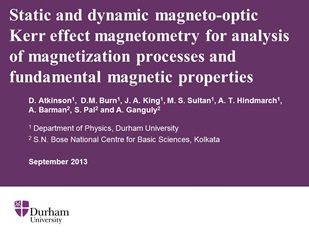
Static and dynamic magneto-optic Kerr effect magnetometry for analysis of magnetisation processes and fundamental magnetic properties
D. Atkinson, D.M. Burn, J.A. King, M.S. Sultan, A.T. Hindmarch, A. Barman, S. Pal and A.Ganguly
Donostia International Conference on Nanoscaled magnetism and Applications San Sebastian, Spain Sep 2013
The application of the magneto-optic Kerr (MOKE) effect has become widespread for the investigation of magnetic thin-films, multilayers and nanoscale magnetic structures. With due care to the experimental arrangement MOKE magnetometry can be exquisitely sensitive to magnetisation changes and can be used to study magnetisation reversal in lithographically patterned structures such as small arrays of nanostructures and individual nanowires. Using the functionally simpler quasi-static focused MOKE arrangement, magnetisation reversal behaviour can be studied as a function of magnetic field. The magnetisation state can be interrogated during the reversal in the case of field driven rotational processes. However, in the case of rapid reversals, for example mediated by domain wall motion in nanowires, the magnetisation process can be followed by interrogating the magnetisation state before and after switching. In the latter case this also presents the opportunity to make multiple measurements and study the stochastic nature of the processes. For lithographically patterned nanostructures typical structures have thicknesses ranging from a few nanometres up to 20 nm. Since the MOKE sensitivity is limited by the skin-depth to the order of 20 nm the technique is highly suited to interrogating the entire thickness of such nanostructures.
Examples of MOKE measurements on such lithographic nanostructures will be discussed. However, this penetration depth limit also makes this technique surface sensitive for materials and structures that are significantly thicker. New results and analysis of MOKE and anisotropic magnetoresistance measurements on the same 200 nm diameter cylindrical NiFe nanowires are compared and contrasted to show the surface magnetisation sensitivity and highlight the complexity of the magnetisation behaviour between the surface and the bulk of these nanowires. In contrast to the more widely used application of MOKE magnetometry for the study of magnetisation processes in thin-films and nanostructures, the magneto-optic Kerr effect can also be used to investigate fundamental aspects of magnetism. Here examples are included which show that under appropriate circumstances the MOKE amplitude obtained from quasistatic measurements can be used to inform on the changes in intrinsic magnetic moment. The method does not give absolute magnetic moment but can show relative changes in moment that can be correlated with direct moment measurements. Furthermore, dynamic MOKE magnetometry is a powerful technique that can be used to study intrinsic precessional magnetisation processes and inform on the magnetic damping. Here examples of the application of MOKE magnetometry to the study of precessional processes are presented that show modifications to the damping in ferromagnetic/non-magnetic bilayered samples by the choice of the non-magnetic layer and the effect of ion beam induced interfacial mixing.